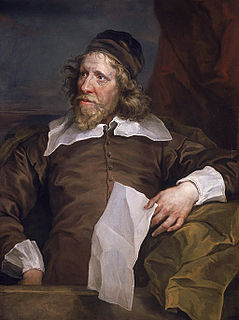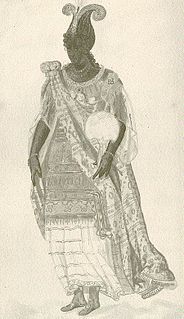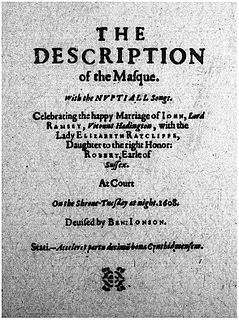Related Research Articles

Inigo Jones was the first significant architect in England in the early modern period, and the first to employ Vitruvian rules of proportion and symmetry in his buildings. As the most notable architect in England, Jones was the first person to introduce the classical architecture of Rome and the Italian Renaissance to Britain. He left his mark on London by his design of single buildings, such as the Queen's House which is the first building in England designed in a pure classical style, and the Banqueting House, Whitehall, as well as the layout for Covent Garden square which became a model for future developments in the West End. He made major contributions to stage design by his work as theatrical designer for several dozen masques, most by royal command and many in collaboration with Ben Jonson.

The Masque of Blackness was an early Jacobean era masque, first performed at the Stuart Court in the Banqueting Hall of Whitehall Palace on Twelfth Night, 6 January 1605. It was written by Ben Jonson at the request of Anne of Denmark, the queen consort of King James I, who wished the masquers to be disguised as Africans. Anne was one of the performers in the masque along with her court ladies, all of whom appeared in blackface makeup.

Hymenaei, or The Masque of Hymen, was a masque written by Ben Jonson for the marriage of Robert Devereux, 3rd Earl of Essex, and Lady Frances Howard, daughter of the Earl of Suffolk, and performed on their wedding day, 5 January 1606. The costumes, sets, and scenic effects were designed by Inigo Jones, and the music composed by Alfonso Ferrabosco.
Love's Triumph Through Callipolis was the first masque performed at the Stuart Court during the reign of King Charles I, and the first in which a reigning monarch appeared. The work was written by Ben Jonson, with costumes, sets, and stage effects designed by Inigo Jones, and music by Nicholas Lanier. This play Also played in Greece national theatre in 1979 together with the Johnsons masques Oberon, the faery prince and News from the new world discovered in the moon. [[ [[ ]]
Chloridia: Rites to Chloris and Her Nymphs was the final masque that Ben Jonson wrote for the Stuart Court. It was performed at Shrovetide, 22 February 1631, with costumes, sets and stage effects designed by Inigo Jones.
Oberon, the Faery Prince was a masque written by Ben Jonson, with costumes, sets and stage effects designed by Inigo Jones, and music by Alfonso Ferrabosco and Robert Johnson. Oberon saw the introduction to English Renaissance theatre of scenic techniques that became standard for dramatic productions through the coming centuries.
Love Freed from Ignorance and Folly was a Jacobean era masque, written by Ben Jonson and designed by Inigo Jones, with music by Alfonso Ferrabosco. It was performed on 3 February 1611 at Whitehall Palace, and published in 1616.
Love Restored was a Jacobean era masque, written by Ben Jonson; it was performed on Twelfth Night, 6 January 1612, and first published in 1616. The Dictionary of National Biography says of the masque, "This vindication of love from wealth is a defense of the court revels against the strictures of the puritan city."

The Hue and Cry After Cupid, or A Hue and Cry After Cupid, also Lord Haddington's Masque or The Masque at Lord Haddington's Marriage, or even The Masque With the Nuptial Songs at the Lord Viscount Haddington's Marriage at Court, was a masque performed on Shrove Tuesday night, 9 February 1608, in the Banqueting House at Whitehall Palace. The work was written by Ben Jonson, with costumes, sets, and stage effects designed by Inigo Jones, and with music by Alfonso Ferrabosco – the team of creators responsible for previous and subsequent masques for the Stuart Court.
The Golden Age Restored was a Jacobean era masque, written by Ben Jonson and designed by Inigo Jones; it was performed on 1 January and 6 January 1616, almost certainly at Whitehall Palace.
Mercury Vindicated from the Alchemists at Court is a Jacobean-era masque, written by Ben Jonson and designed by Inigo Jones. It was performed at Whitehall Palace on Twelfth Night, 6 January 1615. King James I liked it so much that he ordered a repeat performance the following Sunday, 8 January.
The Fortunate Isles and Their Union is a Jacobean era masque, written by Ben Jonson and designed by Inigo Jones, and performed on 9 January 1625. It was the last masque acted before King James I of England, and therefore the final masque of the Jacobean era.
Neptune's Triumph for the Return of Albion was a Jacobean era masque, written by Ben Jonson, and designed by Inigo Jones. The masque is notable for the contradictory historical evidence connected with it and the confusion it caused among generations of scholars and critics.
Pleasure Reconciled to Virtue is a Jacobean era masque, written by Ben Jonson and designed by Inigo Jones. It was first performed on Twelfth Night, 6 January 1618, in the Banqueting House at Whitehall Palace. The work's failure on its initial performance, and its subsequent revision, marked a significant development in Jonson's evolving masque technique.
The Memorable Masque of the Middle Temple and Lincoln's Inn was a Jacobean era masque, written by George Chapman, and with costumes, sets, and stage effects designed by Inigo Jones. It was performed in the Great Hall of Whitehall Palace on 15 February 1613, as one item in the elaborate festivities surrounding the marriage of Princess Elizabeth, daughter of King James I, to Frederick V, Elector Palatine in the Rhineland.
The Masque of Augurs was a Jacobean era masque, written by Ben Jonson and designed by Inigo Jones. It was performed, most likely, on Twelfth Night, 6 January 1622.
The Weeding of the Covent Garden, or the Middlesex Justice of Peace, alternatively titled The Covent Garden Weeded, is a Caroline era stage play, a comedy written by Richard Brome that was first published in 1659. The play is a noteworthy satire on the emerging ethos of Capitalism as reflected in real estate and urban development in the early modern city.
Lord Hay's Masque was an early Jacobean era masque, written by Thomas Campion, with costumes, sets and stage effects designed by Inigo Jones. The masque was performed on Twelfth Night, 6 January 1607, in the Great Hall of Whitehall Palace. It was the premier event at the Stuart Court for the 1606-7 Christmas holiday season.
Luminalia or The Festival of Light was a late Caroline era masque or "operatic show", with an English libretto by Sir William Davenant, designs by Inigo Jones, and music by composer Nicholas Lanier. Performed by Queen Henrietta Maria and her ladies in waiting on Shrove Tuesday, 6 February 1638, it was one of the last and most spectacular of the masques staged at the Stuart Court.
The Vision of Delight was a Jacobean era masque written by Ben Jonson. It was most likely performed on Twelfth Night, 6 January 1617 in the Banqueting House at Whitehall Palace, and repeated on 19 January that year.
References
- ↑ Stephen Orgel, ed., Ben Jonson: The Complete Masques, New Haven, Yale University Press, 1969.
- ↑ Michael Leapman, Inigo: The Troubled Life of Inigo Jones, Architect of the English Renaissance, London, Headline Book Publishing, 2003; p. 209.
- ↑ Jesse Franklin Bradley and Joseph Quincy Adams, eds., The Jonson Allusion Book: A Collection of Allusions to Ben Jonson from 1597 to 1700. New Haven, Yale University Press, 1922; p. 130.
- ↑ Michelle O'Callaghan, The Shepherd's Nation: Jacobean Spenserians and the Early Stuart Political Culture 1612–1625, Oxford, Clarendon Press, 2000; pp. 209–11.
- ↑ Joseph Loewenstein, The Author's Due: Printing and the Prehistory of Copyright, Chicago, University of Chicago Press, 2002; pp. 144–5.
- ↑ Heather Anne Herschfeld, Joint Enterprises: Collaborative Drama and the Institutionalization of the English Renaissance Theatre. Boston, University of Massachusetts Press, 2004; p. 64. Spellings modernized.
- ↑ Leapman, p. 209.